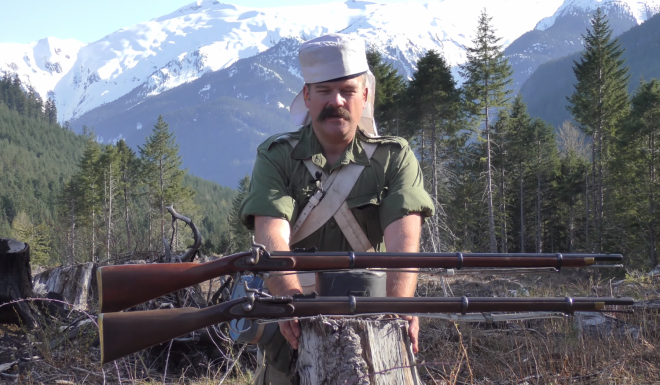While it might seem like a foregone conclusion which would have the higher rate of fire, a muzzle loader or a breechloader, the results and implications are still interesting. In his most recent video Rob over at British Muzzleloaders pits a muzzle-loading Pattern 1853 against a breech-loading Snider-Enfield conversion.
The Snider-Enfield was introduced by the British Army in 1867, based on the breech-loading system devised by Jacob Snider. The system was similar in principle to the contemporary Trapdoor Springfield’s breech designed by Erskine S. Allin. The MkI and MkII Sniders were conversions of older Pattern 1853 rifle muskets while the MkIII, as used by Rob in this video, was built with the Snider’s hinged breech from new.
Rob explains the benefits of the Snider conversion explaining the introduction of ‘the shoe’ or breech to a conventional rifle musket and the advantages of the brass cased self contained cartridge over the paper cartridge. To load the muzzle-loading Pattern 1853 a soldier had to tear his paper cartridge place its contents into the muzzle, take out his ram rod, ram the powder and ball home, return his ram rod and then place a cap on his rifle’s nipple. In contrast with the introduction of the Snider in 1867, he simply had to open the breech, load a cartridge and close the breech.
During the Ashanti War the British troops armed with the Snider-Enfield found that they had almost trebled their firepower over the earlier Pattern 1853. Using contemporary sources Rob explains how the formidable rate of fire provided British troops with a considerable advantage.
In his video Rob times himself firing two practices each with 10 rounds, In the first, firing the muzzle-loading Pattern 1853, he achieves 24 seconds between shots – just under 3 rounds per minute. In the second, with the Snider-Enfield, Rob fires 10 rounds in just 73 seconds. Almost a 300% improvement over the muzzleloader. Rob then visualises what this improvement meant in combat showing how the rate of fire increase put more fire down range.
The video of part of Rob’s ‘Firepower’ series in which he compares the rates of fire and impact of various rifles, often against their contemporaries such as the Martini-Henry, the Lee-Metford, and the SMLE.
 Your Privacy Choices
Your Privacy Choices
